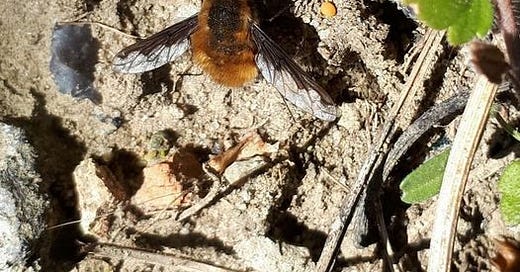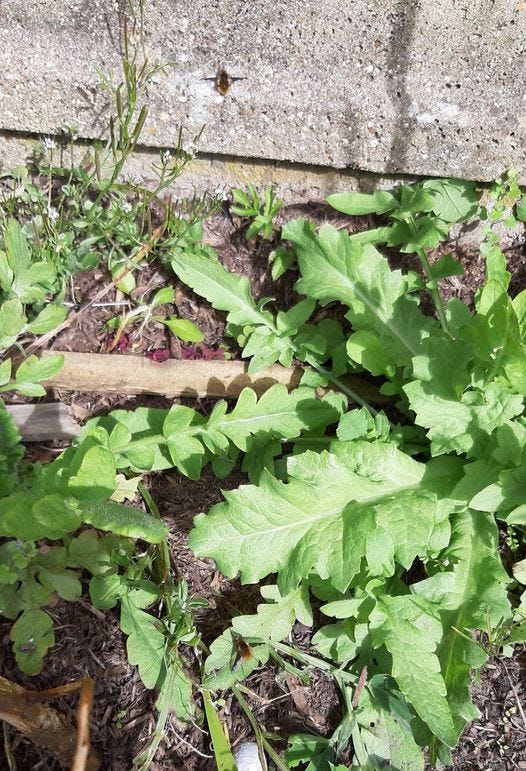There are several sure signs that spring has arrived. Folklore tells us that one is when you can put your foot in a circle of seven daisies, which I was able to do several weeks ago, despite the enduring cold. Another is spotting your first bee-fly, which I am delighted to say I did today. I had gone out thinking that this was a ‘bee-fly kind of a day’, and it seems that it was. It is always a moment of such excitement when the dipping-darting flight catches your eye and, just to add to thrill, today I saw two at the same time! Spring is officially here.
Bee-flies, who can generally be seen between mid-March & May, are not always popular due to their habit of parasitising the nests of solitary mining bees. To me, they are a hopeful sign. If there are bee-flies then the solitary bees are there too. This is a relationship that has existed for many millennia and the bees are still here. All is well. The web of life continues to weave its perfect threads. Our dislike of creatures who parasitise is a sure sign of our disconnection from the deeper, essential patterns those threads are creating.
Aside from that, bee-flies look like little fox-furred flying catkins, which is charming. And they have the most impressive proboscis for sipping nectar, which makes them important pollinators. They are foxes, crossed with catkins, crossed with elephants, crossed with bees. In parts of East Anglia, locals refer to them as beewhals, because their proboscis looks like a narwhal's tusk!
You can watch bee-flies going about their lives here…
As for the bee-flies' relationship with the bees, soon after a female mates she will find the tunnel entrance of a solitary bee's nest, hover over it, & flick her eggs into it. This behaviour has earned them the folk name of bomber flies. Sometimes she misses, but no matter; when her eggs hatch, the larvae will travel into the bee's nest & eat any eggs or larvae they find. If she is unable to find a bee's nest she will lay her eggs on flowers visited by the host, at which point her larvae will attach themselves & be taken back to the nest. Isn’t evolution extraordinary!
That her own eggs survive is in part due to another astonishing adaptation. In some species of bee-fly, the end of the female's abdomen has a sand chamber, filled with collected sand grains. Just before releasing an egg it is coated with sand. It's thought that this improves the female's aim by adding weight to the egg, slows down dehydration, & makes the egg less likely to be recognised by the host bee species. Our own bee-flies use dust for the same purpose, dipping their abdomen into dusty ground before coating the egg.
You can see a female bee-fly coating her eggs in this video from Cumbria Wildlife Trust.
We have astonishing tiny worlds right under our noses!
Bee-flies hide in trees overnight but love sunny days and warm earth, and who could argue with that? Welcome back, little spring sprite!
References:
https://en.m.wikipedia.org/wiki/Bombyliidae
https://www.theguardian.com/.../bee-fly-true-sprite-spring
https://www.discoverwildlife.com/animal-facts/insects-invertebrates/bee-flies/
https://naturalhistorymuseum.blog/2020/04/02/bee-flies-are-back-citizen-science/
https://www.cumbriawildlifetrust.org.uk/blog/wildlife-gardening/fly-disguise-meet-dark-edged-bee-fly
https://www.worcswildlifetrust.co.uk/blog/doorstep-wildlife/taking-bee-fly-walk





Amazing! I have enjoyed all your prayers for all the creatures. There are little lives being lived all around us. Thank you.🐇🐇